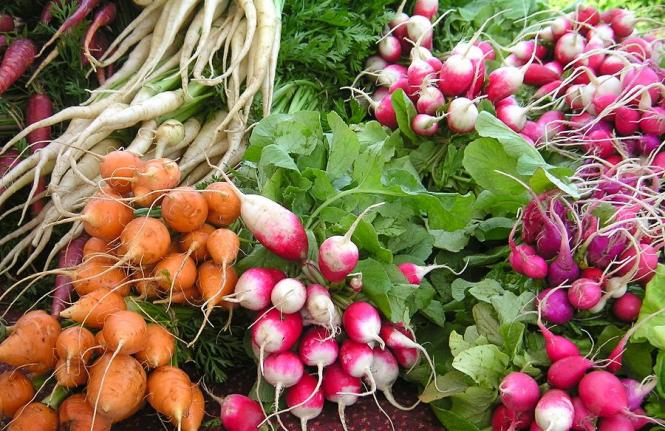Cherry Belle, French Breakfast, White Icicle, Plum Purple – these are just a few varieties of summer radishes that are garnering attention in the produce aisle and at farmers’ markets and gracing CSA (community supported agriculture) boxes. The jewel-toned beauties we’ve been receiving from our CSA are fat and gorgeous, almost too pretty to eat. We ogle, then quickly get them into a salad, or slice for a quick and cooling snack as these sweet and spicy nuggets keep in the refrigerator only for a short time.
This root crop can mature in as little as three weeks, which, for those with gardens, is about as close to instant gratification as growing your own vegetables can get. If left in the ground too long, they can get woody, pithy and mighty spicy, so it’s okay to get greedy with your radish reaping.
 An excellent digestive aid, radishes are also very cooling, which is a welcome relief right about now. With their superhero-like growing powers and internal air conditioning properties, they could rightfully be dubbed The Little Vegetable That Could.
An excellent digestive aid, radishes are also very cooling, which is a welcome relief right about now. With their superhero-like growing powers and internal air conditioning properties, they could rightfully be dubbed The Little Vegetable That Could.
Radishes, which are from the cabbage family, also have powerful antibacterial, anti-fungal and detoxification properties, and as members of the brassica family (which includes cabbage, Brussels sprouts, kale, cauliflower and broccoli), have been lauded as vigorous protectors again cancer. According to Dr. David Servan-Schriber, author of Anticancer, “[Radishes] contain… powerful anticancer molecules and are capable of detoxifying certain carcinogenic substances. They prevent precancerous cells from developing into malignant tumors.”
Don’t Forget the Leaves
Radishes are high in Vitamin C, potassium, and trace minerals, and the leaves are also very nutritious, actually containing more Vitamin C (nearly six times as much) than the roots. Select radishes with bright, supple greens (a telltale sign of freshness) that will add nutrients and flavor to your favorite soups and will also make a delicious stir-fry ingredient. The leaves can be a bit tough, so they’re not ideal for raw salads. Be sure to separate the leaves from the bulb right away and rinse and dry the leaves as you would other greens.
Other little-known benefits of radishes are that they contain antipruritic (anti-itch) properties, making the juice great for bug bites and stings. They also act as a stand-in for a toothbrush and freshen the breath in a pinch.
Filling, cooling and crispy, radishes make a great summer snack. For an instant treat, gnaw at the whole bulb, or slice and dip in guacamole (one of my favorite ways to eat them). For decades, Europeans have taken four ordinary ingredients – bread, butter, radishes and salt – and created what they consider a gourmet delight. However you prepare them, radishes make a snack that packs the crunch, as any self-respecting snack food should do.
* * * * * * * * *
Radish Solitaire
4 small red radishes with greens
5 cups vegetable stock
2 small fresh shiitake mushrooms, thinly sliced
½ ounce fine bean thread noodles
sea salt and ground pepper to taste
Trim away all but the innermost leaf from each radish. Place the stock, mushrooms and noodles in a soup pot, bring to a boil and simmer for 2 minutes, or until the noodles are almost tender Add the radishes and simmer for 2 minutes, or just until the radish turns from red to pink. Adjust seasoning. Divide the soup among individual soup bowls. Serve immediately before the radish color fades.
Source: The New Whole Foods Encyclopedia

Jill Grunewald is a Certified Holistic Health Counselor, health writer, and passionate advocate for sustainable agriculture. Her practice, Healthful Elements, focuses on bio-individual health and whole-foods therapy, with specialization in the endocrine system and hormones, particularly thyroid and adrenal health. Her last post for Simple, Good and Tasty was July is a Berry Good TIme for Nature's Candy.




